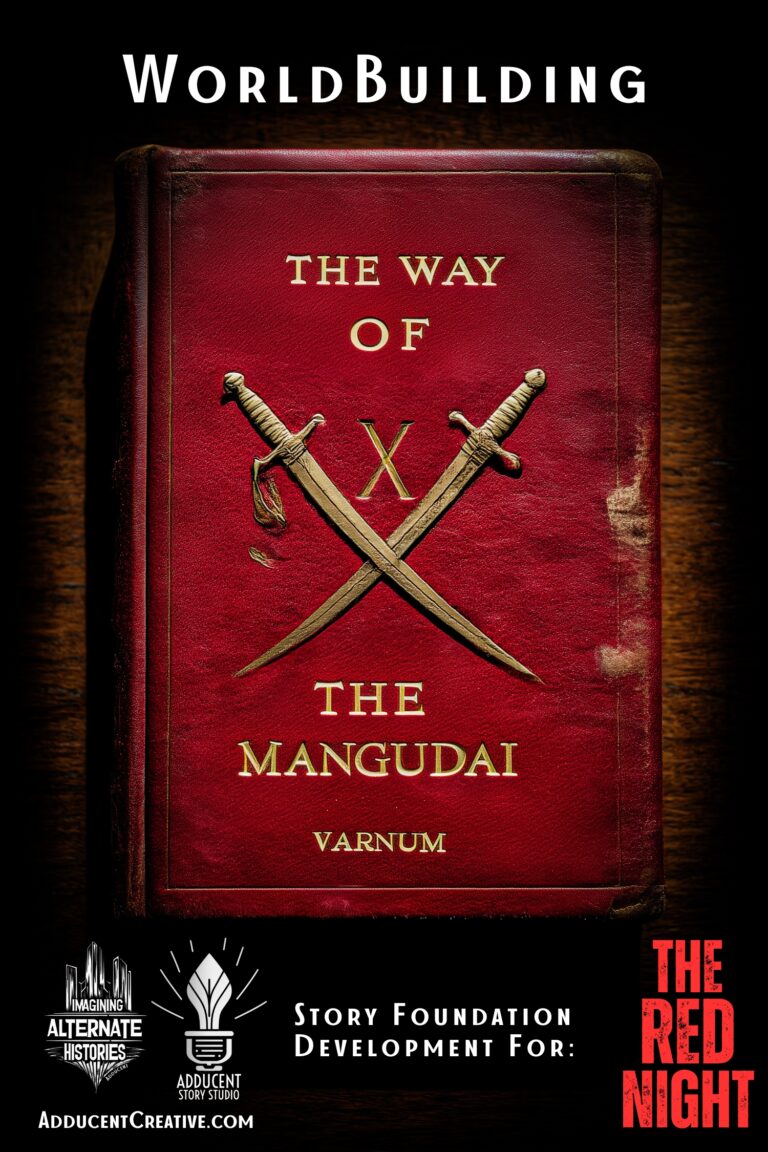
Worldbuilding is an essential aspect of story development, and we use a disciplined approach to our stories and the work we do for clients. We draw on historical documents, reports, information, and cultural research to fashion background, settings, and foundational lore that fit our work. And this foundational piece—a fictitious book we’re creating—perfectly fits THE RED NIGHT, one of our stories in development.
We’ve taken what’s known of the Mangudai, the practices, and principles, and used them as the basis of a fictitious 1930s-era book that is found and read by a young U.S. soldier and OSS officer in 1945 in my story in development, THE RED NIGHT. The soldier is an avid reader and lover of history. In 1945, he found the book in an obscure, dusty, decrepit used bookstore in London. A powerful and thematically rich narrative device, The Way of The Mangudai principles of adaptation, endurance, strength, and mobility of mind and body become a profound metaphor for John Devel’s—THE RED NIGHT’s protagonist’s—transformation. We’ve created a detailed breakdown of this fictitious 1930s-era book to develop how it shapes John Devel’s mindset and tactics in THE RED NIGHT and how it threads through his journey from a wounded combat veteran to confronting a distorted postwar reality. —Dennis Lowery
What follows comes from the first stages of our worldbuilding (subject to further refinement).
Here’s the fictitious book blurb for:
THE WAY OF THE MANGUDAI
A Treatise On A Warrior’s Mind And Movement
Colonel Aldric W. Varnum, D.S.O., O.B.E. (RET.), Late Of Her Majesty’s 4th Hussars
Privately Printed For The Author
ARDENT HOUSE, GLASGOW, 1931
ALL RIGHTS RESERVED
“True strength is not in the hand that strikes first, but in the will that endures—this is the path of the unyielding.”
The Way of The Mangudai is a powerful treatise on resilience and the indomitable will to win—drawn from the battlefield traditions of the Mongol Empire’s most obscure warriors. Written in 1931 by decorated British officer Colonel Aldric W. Varnum, this timeless work explores the tactical brilliance of the Mangudai, elite cavalry who specialized in outwitting larger, more powerful forces through maneuver, deception, and sheer endurance.
But this is more than a study of ancient warfare—it’s a guide for those who have been wounded, outnumbered, or underestimated. Varnum distills centuries of hard-won battlefield insight into strategies for prevailing not with brute force but through adaptability, precision, and resolve.
Whether facing an army or the aftermath of personal loss, The Way of the Mangudai shows how the greatest victories are earned not by those who appear strongest—but by those who can endure and adapt.
For leaders, soldiers, strategists, and survivors… this is the art of turning adversity into advantage and setback into supremacy.
A Contemporary Overview
Conceptual Adoption: ‘Mangudai’ as Training Terminology (1980s–Present)
Origin of the Term’s Use in U.S. Training:
The first appearance of Mangudai in U.S. military culture came not as a combat unit but as a leadership development exercise, originating within elite units, particularly in the U.S. Army’s Special Operations Forces. ‘Mangudai Exercises’ were designed to push officers and NCOs emotionally, intellectually, and physically beyond their limits in scenarios simulating battlefield chaos and ambiguity.
First documented uses were in the 82nd Airborne, Special Forces Groups, and Ranger units, where senior leaders devised multi-day, non-stop tactical simulations intended to exhaust and disorient participants, forcing them to adapt, make rapid decisions, and function while depleted.
The Mangudai Legacy in American Military Thought:
While the original Mongol Mangudai were warriors of the steppes, their principles found a second life in the 20th and 21st-century United States military not through direct emulation but through ideological inheritance:
• Mobility over mass.
• Mental agility over brute strength.
• Disruption over confrontation.
• Leadership under stress.
In American use, the Mangudai has become more than a training label—it is a symbolic rite of passage for those seeking to prove their mettle and ability to lead under extreme adversity.